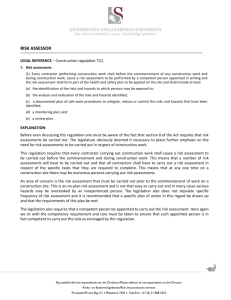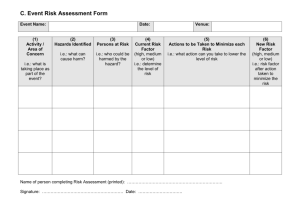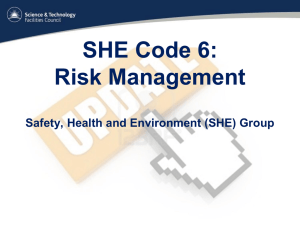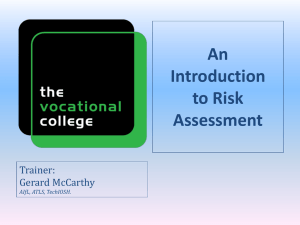General Risk Assessment Guidance
advertisement
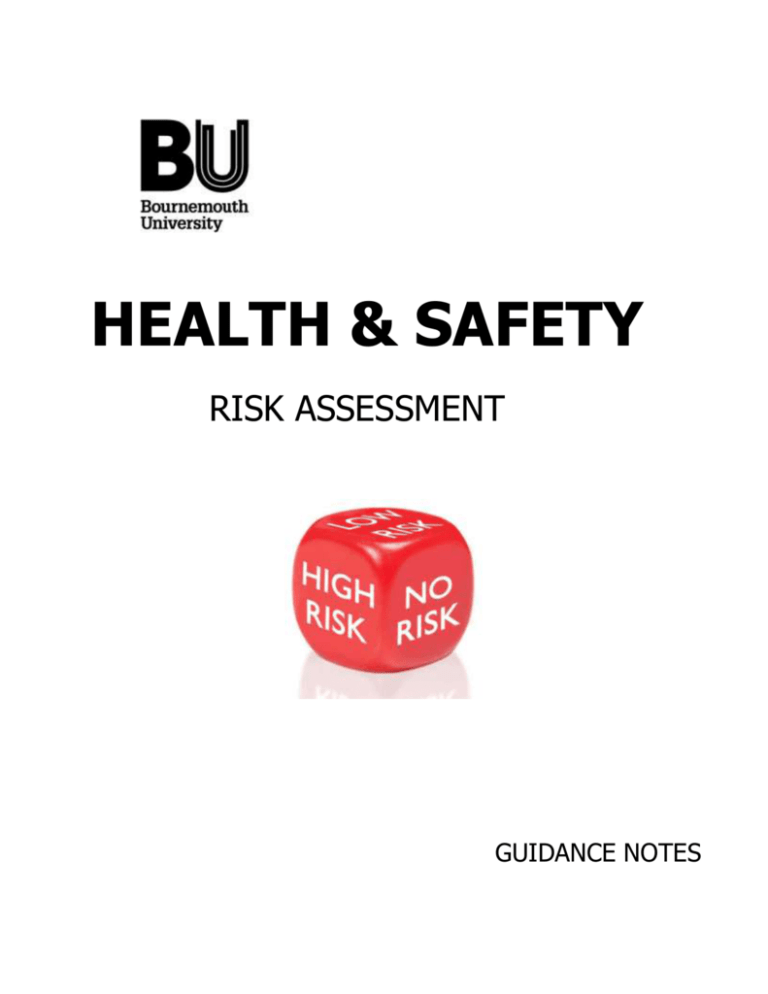
HEALTH & SAFETY RISK ASSESSMENT GUIDANCE NOTES Guidance on Risk Assessment INDEX: Why do we need to do risk assessments? What is a risk assessment? Who is supposed to carry out risk assessments? How are assessments carried out? What if I’ve already got a good system for carrying out risk assessments? When are assessments needed? What sort of hazards should I be considering? What sort of controls should I be considering? What help is available? How do I fill in the University’s General Risk Assessment Form? Where do the assessments go after they are completed? How often do risk assessments need to be reviewed? How does the risk assessment process fit in with our School/Professional Service documentation? Please note – all relevant and related Risk Assessment forms; guidance notes; website links; H&S Individuals contact information etc. detailed in this document are available from the ‘Risk Assessment Resource Section’ of the Health & Safety Intranet (Select ‘Working at BU’ from the Staff Portal Homepage, and then select ‘Health, Safety & Wellbeing’. Why do we need to do risk assessments? Risk assessments are used to reduce the number and severity of accidents by assessing the risks beforehand and introducing appropriate prevention measures. The process of risk assessment is also a useful way of targeting resources i.e. spending time or money on reducing the highest risks first. It’s also required by law. The Management Of Health And Safety At Work Regulations (the ‘Management Regulations’) 1999 require suitable and sufficient recorded assessment of the risks to health and safety to the University’s employees and to anyone else who may be affected by our activities. This law is intended to apply to all significant risks, however for certain activities (e.g. those involving exposure to hazardous substances) more specific regulations have been made and compliance with these will mean that the Management Regulations have also been complied with. This guidance is applicable to most ‘general risks’. However, if you are interested in carrying out specific risk assessments (e.g. for exposure to harmful substances; manual handling; use of display screen equipment; exposure to noise etc.) then you are advised in the first instance to contact your Health & Safety Coordinator. They will then liaise with the University’s Competent Assessor for that activity and/or the Health, Safety & Wellbeing Team to discuss how this should be carried out. Details of our ‘Competent Persons’ are given in the University’s Health & Safety Policy. What is a risk assessment? A risk assessment is nothing more than a careful examination of what, in your work, could cause harm to people so that you can weigh up whether you have taken enough precautions or should do more to prevent harm. The aim is to make sure that no one gets hurt or becomes ill due to work activities. The risk assessment process consists of the following steps: identifying hazards deciding who might be harmed (and how) assessing the risks from those hazards (i.e. the possibility that the hazard will actually result in harm or loss) considering whether further action is needed to eliminate or reduce the risks identified and what would be effective, reasonable and manageable and implementing and maintaining some control measures and programming in a regular review of the assessments Who is supposed to carry out risk assessments? Like all other health and safety duties at Bournemouth University, the overall duty to ensure that risk assessments are carried out lies with the Dean or Professional Services Director and this is specifically written into our general Health & Safety Policy. The tasks themselves will clearly need to be delegated down through line management. Line managers are accountable for ensuring that the person(s) given responsibility for overseeing or carrying out risk assessment actually discharge their duties. Ideally, risk assessments should be organised by the person in charge of that activity. However, the best assessments are carried out as a team effort and should, wherever possible, include those that may be affected e.g. a machine operator. Some risk assessments will require someone with technical expertise (e.g. working with a complex machine), whilst for many assessments this is not needed (e.g. carrying out a general office risk assessment). To quote from the HSE’s ‘5 Steps to Risk Assessment’ leaflet: “In most firms in the commercial, service and light industrial sectors, the hazards are few and simple. Checking them is common sense, but necessary”. If you are struggling to carry out assessments then the University’s Health, Safety & Wellbeing Team can give you advice. Occasionally there may be cases where the responsibilities are not clear-cut. If there is confusion as to who is responsible then this needs to be discussed and clarified with your Dean or Director and with the advice of the Health, Safety & Wellbeing Team. How are assessments carried out? Use the University’s General Risk Assessment Form for all risks except hazardous substances, display screen equipment and manual handling (specific forms are available for these). If everyone uses this form it will make it easier for others to locate the information they need within each form and will ensure consistency. It is recommended that you walk around the workplace and look afresh as what could reasonably be expected to cause harm. Gather information from as many different sources as you can e.g. look through your accident records, speak to the employees about the work and any near-misses, check to see if there are any instruction manuals and whether people are following the recommended precautions. Where the work has already started, try to look at this in practice wherever possible as more hazards and risks may come to light due to factors that may not be noticed from carrying out an assessment away from the activity. Ignore trivial risks and those arising from routine activities associated with life in general and not normally thought of as being of concern. Look for significant hazards, which could result in serious harm or affect several people. Getting bogged down in trivia will make the process unworkable: try to stick to reasonably foreseeable hazards. Risk assess the activity with its present controls (if any), then re-assess if action is to be taken and after further controls are put in place. What if I’ve already got a good system for carrying out risk assessments? It is recognised that certain Schools, Professional Services may have already developed their own systems and forms or may wish to develop these in the future (e.g. for assessing particular hazards). It is the Health, Safety & Wellbeing Teams duty to monitor and audit risk assessments carried out in relation to the University’s activities, it is necessary for them to be aware of these systems. This is in order that advice can be given where necessary and to ensure the quality of risk assessments. The Health, Safety & Wellbeing Team will not be checking the adequacy of all risk assessments, rather they will audit these assessments periodically to ensure the University is complying with its statutory obligations and that general systems of risk assessment are being used as a tool in accident prevention. Auditing of risk assessments will take place against the factors outlined in BS 8800: 1996 so it is expected that any alternative arrangements will be able to reach this standard in order to be accepted by the University as an alternative to the standard method provided by the University. When are assessments needed? Assessments are needed where risks cannot simply be avoided i.e. they are for so-called ‘residual risks’. Carry out the risk assessment before the work starts wherever possible. Ideally, you should try to ensure that the risk assessment process is part of workplanning (rather than always waiting for activities to start before carrying out an assessment). This can help avoid accidents and expensive alterations later e.g. a risk assessment can help in deciding the proper positioning of work equipment. It would not be sufficient to risk assess an activity as a substitute for taking action which could easily avoid that risk. The University is committed in its Policy to following the General Principles of Prevention outlined below. General Principles of Prevention The Management of Health & Safety at Work Regulations 1999 state in Regulation 4 that we should use the following principles to guide our implementation of preventive and protective measures: • Avoiding risks • Evaluating the risks which cannot be avoided • Combating the risks at source (e.g. physical methods rather than signs indicating danger) • Adapting the work to the individual, especially as regards the design of workplaces, the choice of work equipment and the choice of working and production methods, with a view in particular to alleviating monotonous work and work at a predetermined work-rate and to reducing their effect on health • Adapting to technical progress • Replacing the dangerous by the non-dangerous or the less dangerous • Developing a coherent overall prevention policy which covers technology, organisation of work, working conditions, social relationships and the influence of factors relating to the working environment • Giving collective protective measures priority over individual protective measures, and • Giving appropriate instructions to employee What help is available? Initially you should seek the help of your Health & Safety Coordinator and senior colleagues within your Department. It is important that the assessments involve the persons who have knowledge of, and are close to, the activity, as they will know what happens from day-to-day. The Health, Safety & Wellbeing Team can be contacted for advice and assistance but will not carry out risk assessments on behalf of Schools or Professional Services. What sort of hazards should I be considering? Many people are able to talk about the hazards at work but find it difficult to ‘categorise’ them for the purposes of an assessment. For this reason, the University has a form called ‘Hazard and Activity Trawl Form’. The idea is that this becomes a ‘rough filter’ and a basis for discussion so that a decision can be made on what hazards need to be more accurately risk assessed. This form also becomes a record for those hazards that are not thought to be relevant to your work area. How do I fill in the University’s General Risk Assessment Form? A ‘General Risk Assessment form’ is available for risks not specifically related to Manual Handling, Hazardous Substances & Display Screen Equipment (for which other forms are used). On the form there should be plenty of room to type in as much detail as is needed (each section has a maximum of one page length). If necessary, number your points so that they can be cross-referenced from one part of the form to another. The following underlined sections relate to the sections as they appear on the Form: ‘Describe the activity that is being assessed’ : This could be a specific task e.g. floor cleaning, operation of a machine, maintenance activities etc. Try not to include too many activities as it will prove harder to assess their combined risk later - split them up into more manageable steps and do a separate assessment for each – cross referenced to each other. ‘Location’ : Give the room number, building or describe the location of the activity. ‘Persons at Potential Risk’ : When carrying out a risk assessment any person who may be affected by the work that is being assessed must be identified (including employees, the self-employed, the public etc.). Try to consider all persons, even if they have only occasional access. You can group people in categories if this helps e.g. ‘Students’. This form can also be used to risk assess an activity carried out by a single person e.g. if they are carrying out particular work or if they have a disability which requires closer consideration of the risks. Note that in the ‘General Principles of Prevention’ listed above, you have to give “collective protective measures priority over individual protective measures”. This means that if two different assessments produce the same risk rating - but affect different numbers of people - then measures should be taken to reduce the risk to the greatest number of people. Therefore it is a good idea to approximate the numbers of people affected in this section. ‘Potential Hazards’ : Note: The definition of a HAZARD is: - something with the potential to cause harm. Identify the hazards in the activity being assessed. Try to think widely and include anything significant. Remember, this section is to record potential hazards in the absence of any controls you may have in place (the controls are listed and considered in the next sections). If you are struggling to think of hazards or activities you carry out, go through the lists in the ‘Hazard & Activity Trawl’ document - but bear in mind the lists may not cover all situations. Where the risk assessment covers either a field trip or working overseas, the UCEA documents ‘Guidance on Safety in Fieldwork’ or ‘Health and Safety Guidance when Working Overseas’ are extremely useful. These can assist in terms of guidance and in identifying potential risks/hazards inherent with these activities. The HSE (Health & Safety Executive) website is also a good source of information, and covers many of the industries or subject matter covered here at BU. Guidance notes can also provide assistance on the identification of hazards in these particular areas. ‘Any Control Measures Already In Place’ : Outline the existing measures which are already reducing the risk arising from each of the hazards listed. If you have instigated controls in the past but they are no longer effective then do not count them here: instead, you will have to consider their value again under ‘New Control Measures to be Considered’ and discuss whether these controls should be better implemented in the future. Typical control measures (as examples) include: safe design; preventing access to the hazard (e.g. guarding); written procedures and instructions; training & supervision; provision of personal protective equipment (e.g. gloves, masks) etc. Try to avoid using words like ‘be careful’ ‘exercise vigilance’ ‘use common sense’ etc., as these can mean different things to different people. Instead, describe measures that are in place that can be demonstrated e.g. ‘persons using the equipment are trained according to the training plan held by XX’, or ‘all persons using this area are under constant supervision by XX and the activity cannot proceed without this being in place’. ‘Standards to be Achieved’ : This section is for you to write in any relevant standards that exist for this activity. You may need to research this, but the advantage is that if you find a relevant standard it will save a lot of work formulating your own and may ensure that you are complying with the law. Examples include: Regulations, Approved Codes of Practice, other Codes, Industry Guides, Trade Union Guides, Best Practice Guides, Manufacturers or Suppliers Instructions. (if in doubt, consult with your Health & Safety Coordinator &/or the University’s Health, Safety & Wellbeing Team). ‘Estimating the Residual Risk’ : This is the ‘Risk Assessment’ part for risks that haven’t been fully controlled or eliminated. Remember that despite using a ‘rating’ system, risk assessment is not a precise science. The purpose of using a risk rating method is to be able to judge and compare risks and, if necessary, prioritise action on the highest risks. In the event of any accident occurring, the Courts would look to see whether or not the organisation was focusing its efforts on reducing the highest risks through a risk assessment process. However, it is necessary to appreciate that there is a high degree of subjectivity inherent in this process and that it is best used as a tool for comparison within the same risk assessment team. Assess the risks arising out of the hazards identified using the criteria set out in the table provided on page 2 of the form. When carrying this out consideration must be given to what is reasonably foreseeable in relation to the identified hazards (e.g. although you might reasonably predict a risk of a cut to someone’s hand, it would not normally be reasonable to predict that this would then become septic). You can also consider here the effectiveness of any existing control measures that reduce the risk. How to estimate the ‘Residual Risk’: Choose a category that best describes the degree of harm which could result from the hazard (e.g. Slightly Harmful, Harmful and Extremely Harmful). Then select a category indicating what the likelihood is that a person(s) could be harmed (e.g. Highly Unlikely, Likely or Unlikely). Note: the ‘Likelihood of Occurrence’ means the likelihood that the hazard will be realised and harm will result (i.e. not ‘how often does the activity take place’) Then check the ONE box within the table that matches both of your choices and corresponds to the words: Trivial, Tolerable, Moderate, Substantial, or Intolerable. Then take note of the advice below this on the suggested action and timescale. If the overall risk category is ‘Tolerable’ then the assessment is complete and the information contained within the assessment should then be disseminated to those affected. Controls still need to be maintained as you have stated them in the previous box on the form. You should also consider any cost-effective ways to reduce the risk still further (‘cost’ being in terms of money, time or effort). If the overall risk category is ‘Moderate’, ‘Substantial’ or ‘Intolerable’ then additional Control Measures are required: ‘New Control Measures to be Considered’ : Try to avoid reinforcing the status quo. Just because the job’s been done this way for years, doesn’t mean that this is correct or that it’s not an accident waiting to happen! Additional control measures that will reduce the risks further should be noted. The idea is that, once new controls are considered and have been put in place to reduce the risk, then at the review stage these controls (if effective) will be transferred to the section marked ‘Control Measures Already In Place’. This should serve to reduce risks to a level where it is considered that nothing further can reasonably be done to reduce the risks. The hierarchy of control measures that you should consider is, in order of importance: - Eliminate the risk altogether by avoiding the need for carrying out the activity. This can include ‘contracting’ out the activity to others who may be more experienced than you. Substitute the activity with one which is less risky, but still achieves your goals. Reduce the hazard &/or the numbers exposed to the hazard e.g. risks from electrical hazards might be reduced by using low voltage electrical appliances. Prevent access to the hazard: Keep people away from the risk area e.g. by guarding or barring access to the area. Use Personal protective equipment (Gloves, eyewear, shoes, overalls, respirators etc.). Control the activity using a Safe System of Work - along with any training that is relevant for employees expected to adhere to the system. In more hazardous situations a Permit to Work system may need to be instigated. ‘Referred to’: If a new control measure is needed to reduce the risk to an acceptable level but this action is not within your power then fill in the person/department referred to and the date. The person/department that the matter is referred to should be notified under a different cover (i.e. by memo or e-mail). NB: The responsibility for managing the risks cannot be transferred in this way to another Department! You need to ensure that you retain ‘ownership’ of the activity and adjust your controls as necessary in the light of any help you may or may not receive from other Departments. All risk assessments should be open to scrutiny by all interested parties. ‘Ensure that those affected are informed of the Risks and Controls’ If the Residual Risk has been judged to be ‘Moderate’, ‘Substantial’ or ‘Intolerable’ then you should have considered additional control measures to reduce the risk. Once agreed, these controls need to be put in place and you should confirm how you have done this (or how you intend to do this). You may need to come back to this section once this has been discussed with others: if so, write what you are going to do into this section and make sure the ‘review date’ is sufficiently short to ensure the matter does not get forgotten. The persons who may be affected by the activity must be informed as to what the risks are, and what controls have been decided on in order to reduce the risk. There is no set way of giving this communication: you could consider giving them a copy of the assessment (e.g. for staff) or posting signs/warning notices (e.g. for the public). Plus, don’t forget to monitor your own controls if this is important in keeping the risk down. ‘Person(s) Who did Assessment’, ‘Date’, ‘Review Date’ & ‘Checked By’ (see advice above) Where do the assessments go after they are completed? Completing the risk assessment form is NOT the end of the matter! All risk assessments should be brought to the attention of those who are affected by the activities and should be readily available for viewing by interested parties (including Heads of Departments, H & S Co-ordinators, the Health, Safety & Wellbeing Team, HSE etc.). The controls agreed in the risk assessment need to be translated into a safe system of work or simple procedures. The idea is to come to a considered opinion as to what controls are needed to limit harm from potential hazards. Following the assessment, the controls need to be put in place, communicated to all, monitored for their effectiveness and reviewed. The completed forms should be kept within the School/Department, where there should be an appropriate folder set up within your I:Drive so that all necessary parties can access the document. Please refer to ‘Guidance on the Storage of Health & Safety Information on the I:Drive’ for further advice.
